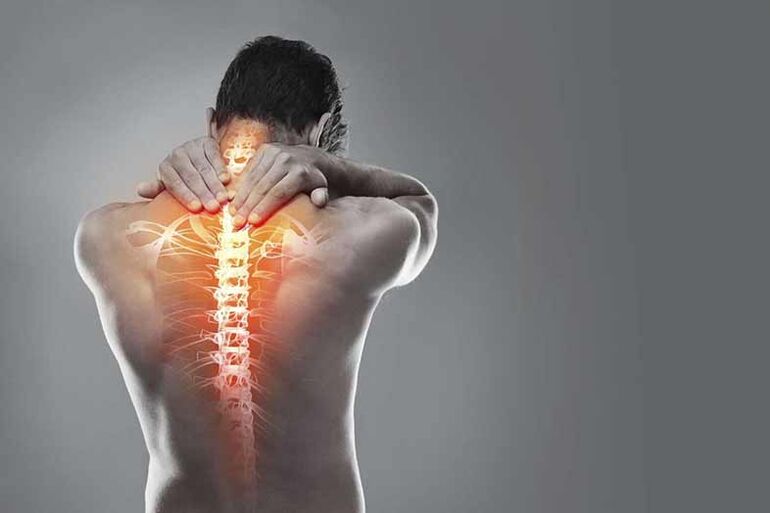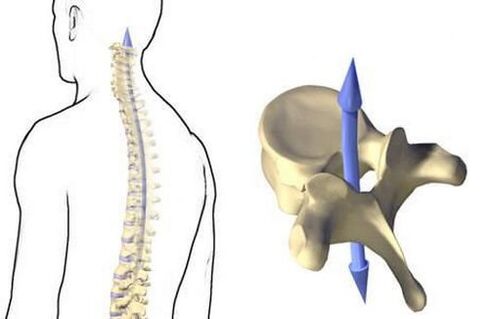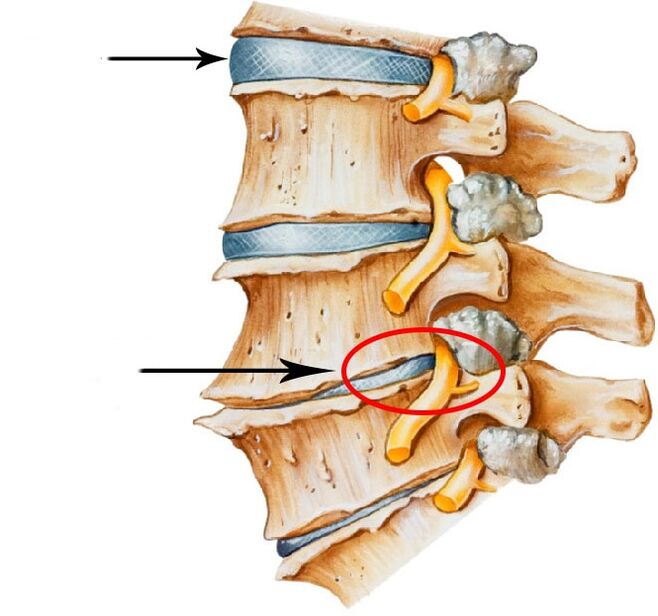
According to statistics, almost half of the already 30 to 55 years at the age of osteochondrosis suffer.The lower age threshold of the disease in recent years has decreased to 18 years.
What is osteocandrose
Osteochondrosis of the spineIt is expressed in the defeat of the intervertebral disc, which loses its elasticity, elasticity and cracks.
Cervical osteochondrosisCombined with damage to the panes in the cervical spine.
How the spine works
If the essence is a little simplified for better understanding, the device of the spine can be described as follows.
The spine consists of separate, similar to in the form of vertebrae that are on top of each other.
Despite some differences in the form, there is a common in the structure of all vertebrae.There is a hole in each vertebra - all holes are also one one above each other and form a vertical channel (tunnel) that drives through the entire spine.
The spinal cord runs in this spine canal.It leads vertically through the holes in every vertebrae and its roots (branches in which sensitive nerve ends) leave the channel between every spine.This is possible because the vertebrae are not lost and are not fixed, and there is a cartilage between each pair of spine - an intermediate disc.

The wheels together with the ribbons connect the vertebrae and also play the role of the shock absorber.Due to their elastic structure, they are elastic pressure during movements and inclination of the body (from the side of the inclination) or laid (when smoothing).Thus, the slices provide the spine with flexibility and soften the load from the vertical pressure from top to bottom to each vertebrae vertebrae of the spine and the vertical vibrations that occur when walking or running.After all, a person is a unique upright and uncomplicated creature.
Such a work of the spine is ensured if the entire load is correctly distributed.Nature has created the spine incredibly stable, hardy and at the same time flexibly.
And if not?
If the form of the spine designed by nature is violated for some reason (bending down, excessive bend in the lower back, scoliosis, flat feet) or a constant chronic habit, to be, to stand, to stand, to stand, lose the intervertebral compounds, lose their elasticity, which is the ability to carry out the shock absorption function.They protrude to the sides and form a hernia.
The wear of the intervertebral discs - there is also a person's billing.After all, the spine only has a vertical stress in humans.Such a vertical press during the entire life of all components of the spine (especially in people with excess weight) leads to gradual deterioration in blood supply to the intervertebral discs (the direction of vessel is pressed) - the hard disk loses endurance and strength.
What next?

Display hernia keeps pressingBlood vesselsPresentNervous rootsand sometimesSpinal cord.
The consequences of cervical osteochondrosis
Due to changes in the anatomical conditions in the spine, blood vessels (the main arteries and veins) are pressed.
What happens:Due to changes in the anatomical conditions in the spine, blood vessels (the main arteries and veins) are pressed.What leads to:
- to violate blood flow into the brain and to violate a full diet of the brain.
- to violate venous drainage and the accumulation of toxic substances in the tissues of the brain.
How it manifests itself:
- Dizziness (until short -term loss of consciousness).
- Headache.
- Visual impairment.Violation of the smell, taste.
- Bulbar disorders in connection with the difficulties of sip, pronunciation, violation of general and language breathing.
- Cognitive disorders: impaired memory, perception, complexity with concentration of attention, complexity with logical thinking.Violation of reading.
- Absent medication memory.Inappropriateness.Acceptance of the confusion.Forgetfulness.
- Difficulties in pronouncing complex and long words, complex grammatical constructions.
- Reduced performance, revise.
- Violations in emotional and personal sphere: sharp and unreasonable mood swings, emotional incontinence, irritability, anger.
Diagnoses: Cognitive diseases, aphasia, bulbardysarthria, disultress encephalopathy, swivel-baslar failure (VBN) etc. can be diagnosed. In these cases, drug therapy was taken:
- Vascular medication.They have an extremely low proof of evidence.They require the use of the doctor and under the control of a doctor you can cause a large number of different complications and side effects.
- NOOTROPE medication.Request strictly for the appointment and under the control of a doctor.Many have fairly serious contraindications from the cardiovascular system (with hidden cardiac pathology, serious negative consequences can cause).Most nootrope have no positive pharmacological result, which means it is useless.
- Medicines with soothing effects, including sedatives, antidepressants, barbiturates, bromids.Psychopharmaceuticals.Request strictly for the appointment and under the control of a doctor.You can make addictive and have several side effects (dizziness, headache, visual impairment and urination, dry mouth, nausea, etc. Shame disorders, a decrease in libido, sleep disorders, a body weight set).
There is a press (compression) of nerve roots - nerves that come from the spinal cord to organs and tissues of the upper body.
What happens:
There is a press (compression) of nerve roots - nerves that come from the spinal cord to organs and tissues of the upper body.
What leads to: To a pronounced pain syndrome, often chronic, recurring.
How it manifests itself:
- Pain in the neck, back of the head (with the head wins or in peace, shots or chronic).
- The headache (headache of tension in connection with the tension of the muscles of the rear surface of the neck and head of the head - pain, poured over the entire head, which often accompanies and rings in the ears, flies in front of the eyes).
- Pain in the upper breast.
- Pain that simulate pain in the heart in the lungs.
- Pain in the upper back in the shoulders, shoulders.
- Pain in the shoulder joint or by hand.
- Taub of the fingers, hands, hands completely.
In these cases, drug therapy was taken:
- Non-steroidal anti-inflammatory medication (pain reliever, antipyrically) that need the use of strictly for the appointment and under the control of a doctor and negative reactions from the gastrointestinal tract (gastritis, ulceration, ulcerative bleeding), cardiovascular system.
- Preparations that alleviate the muscle hypertension that must be used exclusively for its intended purpose and under the control of a doctor in the form of a strong dizziness, weakness to completely exhausting effort.
The use of drug therapy is the most common practice in the treatment of osteochondrosis.However, this is symptomatic treatment.Medicines are used to stop inflammatory processes and pain (sometimes you have to fall back on novocaine blockade), a decrease in neurological and psychoemotional symptoms.The most important thing is that pharmacological therapy occurs under the strict supervision of a doctor.
However, if you do not directly stop the process of violation of the vessels, do not restore the balance of the spine and all related structures (violation of the body's symmetry, flat feet, muscle cramps, which occur as a compensatory reaction to balance), the disease will eventually become everywhere and at some point it does not help and should not help and should resort the operation.
Osteopathic treatment aims to eliminate the above causes of osteochondrosis, which are now most effective.
Osteopathic treatment of osteocandrose
Rule No. 1 "The earlier, the better" in the case of osteochondrosis, it works special!In order to heal osteochondrosis - after all, does not mean deleting pain or other syndromes, but to restore the normal position of the spine in order to provide the intervertebral disc with lost full diet (to return normal blood supply), even before the degenerative processes in the cartilage tissue become irreversible.
The osteopath determines the place where the shift or deformation has occurredThe reasons why the vessels of the vessels occurred in the spine.Osteopathy sees the body as a single system in which everything is connected to each other and influences each other, literally one after the other.This means that the osteopath restores the work of all structures that led changes in the chain to a violation of the power of the intervertebral disc.The task of the osteopath is to restore the equilibrium ratio of organs and tissues and to eliminate the tensions and clamps that affect full nutrition.And if, in the event of a neglected state of the disease, changes in the structure of the spine contains a violation of the work of the internal organs, osteopathic treatment will aim to eliminate the emerging dysfunction.
This means that the osteopath works with the basic cause of the disease and not with the elimination of its syndromes, including pain.Although he will start work with the facilitating of pain.However, it won't stop here.The best type of osteopathy works in combination with physiotherapy (ensures a reduction in pain and inflammatory processes) and physiotherapy exercises - training therapy (strengthens the sore muscles, helps the body to remain in a new unusual but adequate position).
Conclusions
- The neck cannot be treated lightly.Because the brain should be supplied with unhindered nutrition.And it depends on how much the neck is a healthy "conductor".
- You can hardly wait.The more the disease comes onto the market, the more difficult it is to roll it back (and sometimes impossible).Osteopath is able to determine the disease when it is still in the rudiment and does not manifest itself in any way.You should never neglect a diagnostic examination.
- It is impossible to neglect the prevention of osteochondrosis.It is always easier than the treatment of the disease.



























